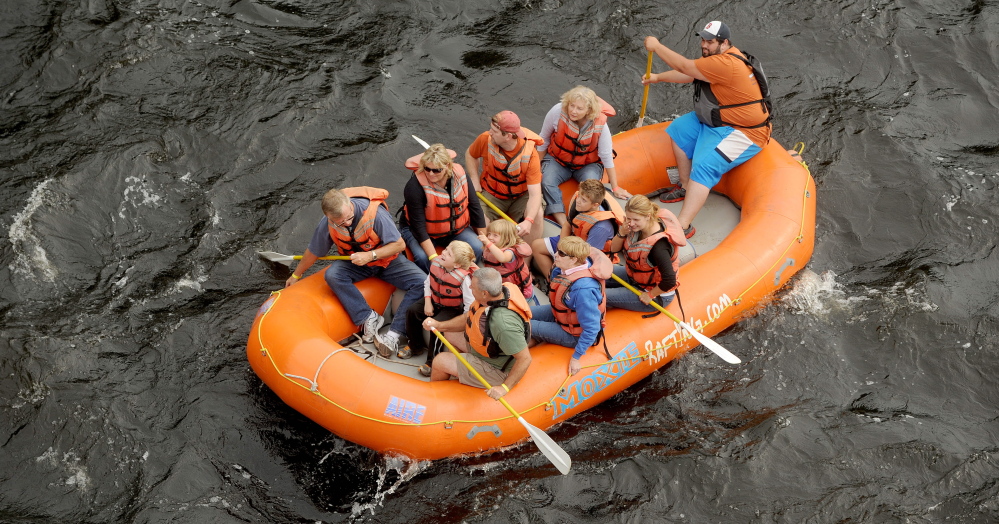SKOWHEGAN — The proposed Run of River whitewater park through downtown Skowhegan could generate $6 million in revenue and 43 local jobs in just the first year of operation, according to an economic impact study.
After more than 10 years of planning, organizers released the study estimating the park could provide Somerset County with jobs in restaurants, hotels and businesses associated with paddling, canoing and kayaking.
The study, released by Planning Decisions Inc. of Hallowell in conjunction with Main Street Skowhegan, notes that the project, with its man-made bumps and whitewater rapids, could also produce as much as $19 million and as many as 136 local jobs in its 10th year of operation.
The “play park” for paddling, canoing, kayaking and tubing, with four-season amenities of trails, competitions and spectator posts along the river route, also would generate an estimated $155,000 in new tax revenues from increased property values in the first year and more than $200,000 in added state income- and sales-tax revenues, according to the study.
Each of the proposed whitewater features has at least a 2-foot drop with a calm water area for resting and self-rescue in the event of a capsize. The impact study notes that maintenance of the physical infrastructure of the park would be “modest” because the man-made structures would be anchored in bedrock on the river bottom.
Proposed features consist of man-made constrictions that squeeze and funnel the river to create elevation drops and high-velocity water needed for whitewater waves. The waves themselves would be created by low, mounded obstacles within the existing fast water of the Kennebec to make water holes, ramps and tubes for standing waves and rapids.
Each whitewater feature will consist of a group of two or three obstacles at different elevations, each tuned to a different flow range of the river. As the river rises, the lowest feature washes out and the next feature comes in, according to the model.
The features are arranged in a stepped fashion to focus the flow to the middle of the river and are less likely to impede fish passage.
Kristina Cannon, executive director at Main Street Skowhegan, said the first draft of the impact study was presented to selectmen earlier this year, but the board had questions. Frank O’Hara of Planning Decisions and Kenneth Young returned Tuesday to present the second draft of the study.
“We did some additional research about the paddling community in New England – how many people actually kayak and canoe – based on the number of clubs and members each club has,” Cannon said.
Organizers also searched social media to determine what level of support a whitewater park would have in Skowhegan, Cannon said, noting that the “paddling community” in Maine is estimated to be about 7,600 people. Nationally, there are several organizations that may be interested in seeing what Skowhegan has to offer.
There is the New England Slalom Series of races that could attract enthusiasts from USA Freestyle Kayaking’s National Whitewater Freestyle Championship, Cannon said.
She said Clayton Cole, president of the American Canoe Association–New England, attended Tuesday’s presentation and is interested in possibly hosting paddling events down the Kennebec River Gorge just below the dam where the park is to be located.
The next step, she said, is to create a business plan, launch a capital campaign and initiate the permitting process. The committee will not ask for money from the town, but will apply for grants and “look for big donors,” she said.
Skowhegan Town Manager Christine Almand said summer tourists come through Skowhegan going north to whitewater sites in The Forks and south to Maine beaches. It only makes sense, she said, to offer them good reasons to stop and play in the Kennebec along the way.
The project also would improve physical and visual access to the gorge by creating two footpaths down to the river and terraced seating along the shore.
Planning for the park began in 2004, and town officials finally saw a digital model of the park in 2014. An $80,000 U.S. Department of Agriculture rural business opportunity grant was used to complete engineering of the model, a requirement for the many permits the park will need. The model will have to pass scrutiny of agencies including the state Department of Environmental Protection, the Army Corps of Engineers and the Department of Inland Fisheries and Wildlife. Maine’s Indian tribes also will weigh in on the project, as will Maine historic preservation groups.
Funding for the park would come from grants from state and federal agencies along with private businesses and money sheltered from the Sappi paper mill’s tax increment financing district.
Send questions/comments to the editors.



